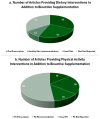Evaluating Bioactive-Substance-Based Interventions for Adults with MASLD: Results from a Systematic Scoping Review
- PMID: 39940310
- PMCID: PMC11820841
- DOI: 10.3390/nu17030453
Evaluating Bioactive-Substance-Based Interventions for Adults with MASLD: Results from a Systematic Scoping Review
Abstract
Objective: Metabolic dysfunction-associated steatotic liver disease (MASLD) is a chronic condition affecting a broad population. This review aimed to identify and summarize the current evidence on bioactive-substance-based interventions for adults with MASLD, formerly known as nonalcoholic fatty liver disease (NAFLD), covering publications from 2000 to 2023. Methods: A search was conducted across six databases (MEDLINE, CINAHL, Cochrane CENTRAL, Cochrane Database of Systematic Reviews, Food Science Source, and SPORTDiscus) for randomized controlled trials and other study types (e.g., prospective cohort studies and systematic reviews), reflecting the scoping nature of this review. The search was limited to studies in adults (>18 years old), with an intervention of interest and at least one comparator group. Results: A total of 4572 articles were retrieved, with 201 full-text articles screened for eligibility. Of these, 131 primary studies and 49 systematic reviews were included in the scoping review. The most studied bioactive substances were Curcumin (Turmeric) (n = 25), Silymarin (Milk Thistle) (n = 17), Resveratrol (n = 10), Coffee (n = 7), Green Tea (n = 5), and Berberine (n = 5 each). Moreover, 46 studies reported on 36 other bioactive substances with 2 or fewer articles each. Among the included systematic reviews, 13 focused on Curcumin, 12 on Coffee or Tea, 10 on bioactive substance combinations, 6 on Resveratrol, and 2 each on Silymarin and Artichoke Leaf. The included studies showed substantial heterogeneity in reported outcomes, which primarily focused on hepatic health, body weight, adverse events, glycemic control, blood lipids, and body composition. Conclusions: This scoping review highlights a range of bioactive substances used in the treatment of MASLD. While evidence is abundant for bioactive substances like Curcumin and Silymarin, further research and synthesis of findings is necessary to establish the clinical efficacy of all bioactive substances.
Keywords: MASLD; bioactive substances; lifestyle management; non-alcoholic fatty liver disease; scoping review.
Conflict of interest statement
The authors declare no conflicts of interest related to this work. The funders had no role in the design of the study; in the collection, analyses, or interpretation of data; in the writing of the manuscript; or in the decision to publish the results [197,198,199,200,201,202,203].
Figures





References
-
- Zeng X.F., Varady K.A., Wang X.D., Targher G., Byrne C.D., Tayyem R., Latella G., Bergheim I., Valenzuela R., George J., et al. The role of dietary modification in the prevention and management of metabolic dysfunction-associated fatty liver disease: An international multidisciplinary expert consensus. Metabolism. 2024;161:156028. doi: 10.1016/j.metabol.2024.156028. - DOI - PubMed
-
- Yates A.A., Dwyer J.T., Erdman J.W., King J.C., Lyle B.J., Schneeman B.O., Weaver C.M., serving as an ad hoc Working Group on a Framework for Developing Recommended Intakes for Dietary Bioactives Perspective: Framework for Developing Recommended Intakes of Bioactive Dietary Substances. Adv. Nutr. 2021;12:1087–1099. doi: 10.1093/advances/nmab044. - DOI - PMC - PubMed
-
- Arksey H., O’Malley L. Scoping studies: Towards a methodological framework. Int. J. Soc. Res. Methodol. 2005;8:19–32. doi: 10.1080/1364557032000119616. - DOI
Publication types
MeSH terms
Substances
Grants and funding
LinkOut - more resources
Full Text Sources
Medical

